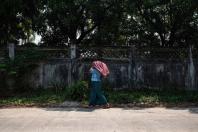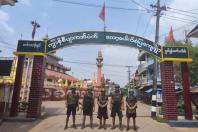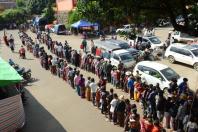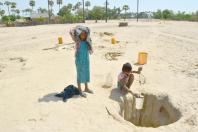■ Afghanistan War
The United States did what we went to do in Afghanistan: to get the terrorists who attacked us on 9/11 and to deliver justice to Osama Bin Laden, and to degrade the terrorist threat to keep Afghanistan from becoming a base from which attacks could be continued against the United States. We achieved those objectives. That’s why we went. We did not go to Afghanistan to nation-build. And it’s the right and the responsibility of the Afghan people alone to decide their future and how they want to run their country.”
(Remarks by President Biden on the Drawdown of U.S. Forces in Afghanistan at the White House on July 8, 2021)
The Afghanistan War was the worst as well as the most irresponsible and embarrassing. The United States had military involvements across the world on the pretext of human rights and democracy. In the Afghanistan issue, the U.S. raised a new title under the name of “counter-terrorism”.
However, the U.S. got involved in Afghanistan affairs to serve its security interests. It is embarrassing that the U.S. left the country in a state of chaos after realizing its goal.
The U.S. pretended to be the savior of Afghanistan the freed the Afghan people who were aspiring to attain democracy from the Taliban. However, it is extremely irresponsible for the U.S. to have left the country in limbo after achieving its own goals. Sadly, the Afghan people have fallen again under the Taliban rule. They have no choice, but to suffer a wide array of oppression by the Taliban, including the strict Sharia law. The scenes of desperate Afghans clinging tightly to the side of a moving US military plane leaving Kabul airport is a tragedy and has served as a historical lesson.
The scenario in which the Taliban’s return to power will provide international terrorists or terrorist organizations as a hideout in Afghanistan, which will cause instability in that Afghanistan as well as in the region provides plenty of food for thought. Moreover, as the U.S. has left behind assorted state-of-the-art weapons in the country, its intervention in the name of “counter-terrorism” may have become a sham.
The lesson provided by American intervention in Afghanistan is an alert for the Myanmar people as well. Currently, the U.S. is completely occupied with Ukraine over a proxy war with Russia. Thinking that the Myanmar issue is still unimportant, the U.S. has only put it in its NDAA. Meanwhile, Nancy Pelosi, speaker of the House of Representatives, visited Taiwan on August 2, 2022 showing that the United States is invested in the containment of Taiwan. Aftere the Ukraine issue has been resolved, the U.S. will likely to return to the issues of China’s southern neighboring countries, including strategically important Myanmar.
The United States spent US$2.26 trillion in Afghanistan, the Costs of War Project at Brown University calculates – an investment that has yielded a chaotic, humiliating end to America’s longest war.
Afghanistan was not useless. It was able to vie with the superpowers that encroached upon its territory. In the 19th, 20th and 21st centuries, Britain, Soviet and the U.S. occupied Afghanistan, but history has underscored that these superpower occupiers all had retreated in defeat.
■ 9/11 (2001)
The al-Qaeda-backed Wahhabi Islamist terrorists attacked Twin Towers of the World Trade Center in New York City, killing a total of 2,996 innocent people. Nineteen terrorists hijacked four commercial airliners scheduled to travel from the New England and Mid-Atlantic regions of the United States to California. The hijackers crashed the first two planes into the Twin Towers of the World Trade Center in New York City, and the third plane into the Pentagon (the headquarters of the United States military) in Arlington County, Virginia. The fourth plane was intended to hit a federal government building in Washington, D.C. but crashed in a field following a passenger revolt.
No Afghan was among those 19 terrorists. At that time, U.S. President George W Bush declared that anti-terrorism war must be waged targeting al-Qaeda.
The War in Afghanistan took 19 years 10 months one week and one day from October 7, 2001 to August 15, 2021.
■ Geography and background history
Afghanistan shares a border of 76 kilometers (47 miles) with China. Afghanistan officially called the Islamic Emirate of Afghanistan is a landlocked country located at the crossroads of Central Asia and South Asia. It is bordered by Pakistan to the east and south, Iran to the west, Turkmenistan to the northwest, Uzbekistan to the north, Tajikistan to the northeast, and China to the northeast and east.
Looking back to history, Afghanistan located on the route connecting Central Asia and South Asia has been invaded several times. Some of the invaders in the history of Afghanistan include the Maurya Empire, the Ancient Macedonian Empire of Alexander the Great of Macedon, the Rashidun Caliphate, the Mongol Empire led by Genghis Khan, the Timurid Empire of Timur, the Mughal Empire, various Persian Empires, and the British Empire.
■ United States-Afghanistan relations
The U.S. established diplomatic ties with Afghanistan in 1932. The U.S. provided US$500 million in aid to Afghanistan for its economic growth. In December 1979 during the Cold War that changed power balance when Soviet invaded Afghanistan, the United States started supporting the resistance forces. The governments of both Jimmy Carter and Ronald Reagan provided up to US$3 billion in military aid to the Mujahideen rising against Soviet. As of earlier 1980, the U.S. used Inter-Services Intelligence – ISI of Pakistan as a tool to resettle tens of thousands of Afghan refugees and provide weapons and cash assistance to the Mujahideen. Soviet troops retreated in 1989.
■ Afghan geopolitics as the Cold War near-ended
The political power and territorial control by the US-led capitalist countries and Soviet-led communist countries after the Second World War lasted nearly 50 years from 1945 to the 1990s. Those years were regarded as the Cold War. Although there was little confrontation to cause the Third World War, both the United States and Soviet didn’t hesitate about seek their proxy countries or puppet governments.
Soviet-Afghan Friendship Treaty was signed in 1978. The agreement included a paragraph saying that there would be mutual assistance in economic and military affairs. Soviet viewed the Afghan border areas as major entrances to Asia. Russia therefore wanted to assure long-term bilateral friendship to its national interests for centuries.
In 1978 when Afghanistan exercised single-party system, Nur Muhammad Taraki served as leader of the communist party, but public support was substantially decreasing. When his men from the party killed in September 1979, Russia took advantage of the treaty.
Soviet troops invaded and occupied Afghanistan on December 24, 1979. Soviet leader Leonid Brezhnev sent three divisions, each of which comprised 8,500 troops, with 280 transport planes. Despite intense resistance, Tajbeg Palace and Kabul could be controlled within days.
Marxist People’s Democratic Party of Afghanistan - PDPA elected Babrak Karmal as Afghan leader and reconstituted the government at their disposal. Meanwhile, Soviet foot soldiers from northern Afghanistan were able to enter the country. Soon after that, resistance groups emerged across the country. They were mobilized by the Mujahideen. Mujahideen, or Mujahidin, is the plural form of mujahid, an Arabic term that broadly refers to people who engage in jihad. The main reason for their unification was that they had common goal of believing that Soviet people were atheists who are a barrier to Islamism and culture. Among the resistance groups were fundamentalists based on religion or race and war veterans. The West bloc praised them for being independence fighters. They were backed and financed by the United States and Pakistan.
In 1980, US President Jimmy Carter provided arms to the Mujahideen through Pakistani intelligence, and Saudi Arabia contributed money. In Pakistan-sponsored distribution of the money and weapons, deciding which mujahideen groups should be supported and how much, extremist groups usually get more quotas. The Mujahideen were able to mobilize the Afghan people in rural areas.
In 1981, the United States gave Pakistan the green light to provide economic and military aid for the Afghan civil war, and support increased under President Ronald Reagan. Three billion US dollars were spent on the famous joint exercise called Operation Cyclone.
By 1987, the U.S had supplied shoulder-fired anti-aircraft missiles called Stingers that enabled the Mujahideen to shoot down Soviet aircraft and helicopters. Stinger turned the tide of the battle and allowed the Mujahideen to gain control of much of the country.
As the situation has become unstable, the Soviet-influenced government announced it will end the one-party system and an election would be held.
■ Mujahideen, Al-Qaeda and the Taliban
In 1988, Soviet leader Gorbachev began withdrawing Soviet troops from Afghanistan. Election was held in April, a coalition government was formed, and Mohammad Najibullah was appointed as interim leader, leaving 50 parliamentary seats open for the Mujahideen to enter if they lay down their arms.
In fact, history has been set for another superpower, the United States, to enter Afghanistan that same year.
On August 11, 1988, during the Soviet-Afghan War, Osama bin Laden, Abdullah Azzam and other groups successfully formed al-Qaeda, an armed Sunni Islamist group. Bin Laden based in Pakistan, was a major financier of the Mujahideen in the 1980s. He also trained Muslims who wanted to fight from abroad.
On February 15, 1989, the last Soviet troops withdrew from the Afghan border. The Mujahideen continued to fight the Moscow-backed Najibullah government while receiving financial support from Washington and Islamabad.
In the Afghan-Soviet war that lasted nine years, one month, three weeks and one day, 14,453 people died, 53,753 wounded and 264 people are missing on the Soviet side and more than 18,000 from Soviet-backed Afghan forces had been killed. At least 90,000 people from the Mujahideen were killed. As for Pakistan, which fought together, 5,775 were killed and 6,804 were wounded.
In the 20th century, even though the invasion of Afghanistan by the superpower Soviet Union, which lasted for almost ten years, cost the lives of troops and money, it was not only ended in withdrawal, but also gave birth to violence and extremist groups.
When the Soviet Union withdrew from the country, the Taliban, one of the groups that fought in the civil war during a time when there was no government and a one-man rule, emerged in Kandahar, second largest city in Afghanistan located in south of the country, in 1994. The term “Taliban” is a Pashto language meaning “student”.
In terms of war, around 1980, when Soviet troops invaded Afghanistan, the United States supported a rebel group called the "Mujahideen" to fight the Soviet Union. The founding fathers of the Taliban were from the Mujahideen group.
Within two years, the Taliban gained control of the entire country, and in 1996, Afghanistan was declared as Islamic Emirate, and Islamic law was enforced and interpreted as necessary. Other Mujahideen groups retreated to the north of the country.
■ America's war in Afghanistan
The war in Afghanistan is a war in which the United States-led international forces invaded and occupied the Islamic Emirate that was previously ruled by the Taliban. The war lasted 19 years, 10 months, three weeks and two days from October 7, 2001 to August 30, 2021, making it the longest war in American military history.
On September 11, 2001, the twin towers of the World Trade Center were attacked in Manhattan, New York, United States. Then, US President George W. Bush announced that “We must wage a war against terrorism,” and Osama bin Laden and al-Qaeda in Afghanistan were the targets of the war against terrorism. Under the name of “War on Terror” operation, Al-Qaeda hideout areas were identified and Afghanistan was invaded and occupied. The Taliban government collapsed, and a US-led interim puppet government gained power. Since then, the Taliban had reached the form of a rebel army that was fighting successive puppet governments installed by the United States.
According to the historians, they defined from the beginning of the war to the end of 2014 as the first part and from early 2015 to the middle of August 2021 as the second part.
The war, which began on October 7, 2001, was dubbed “Operation Enduring Freedom” and began with a bombing campaign against Taliban forces. Britain, Canada, Germany and France joined the war, targeting the Taliban and al-Qaeda. The U.S sent 1,000 Special Forces to help fight along with Northern Allies and the Pashtun tribes against the Taliban. After 12 days of air warfare, the ground combat could begin.
In November 2001, the Taliban government began to disintegrate, and they had to give up big cities like Teloqan, Bamiyan Herat, Kabul and Jalalabad. On November 14, according to Security Council Resolution 1378 of the United Nations, it stated to establish a transitional administration, to send peacekeeping forces from the member countries for stability in the country, and help with the necessary support.
Al-Qaeda leader Bin Laden escaped Afghanistan in December 2001, regardless of intelligence and modern methods of tracking. He escaped from Afghanistan on horseback from a cave in the Tora Bora mountains southeast of Kabul.
After the fall of Kabul from the Taliban, a conference was held in Bonn, Germany, hosted by the United Nations and invited to Afghan groups, and on December 5, all groups signed the Bonn Agreement. The Interim Council led by Hamid Karzai installed by the United Nations. According to Security Council Resolution 1386, the International Security Assistance Force (ISAF) was established.
Looking back at the results of the first six months since the start of the war, the victory was led by the United States and saw the fall of the Taliban government, the formation of an interim government in Afghanistan, establishing the International Security Assistance Force (ISAF), ending the ongoing civil war between the Taliban and northern groups, transforming the Taliban as insurgents and rebels and deploying of the US troops in Afghanistan.
In June 2002, an emergency conference attended by 1,550 delegates from Afghanistan's 364 provinces elected Hamid Karzai as head of the interim government. Starting from November of that year, the urban administration and non-governmental organizations cooperated with the development, restoration work has begun. In May 2003, Defense Secretary Donald Rumsfeld announced that the main operation was over.
In January 2004, 502 Afghan delegates agreed to a constitution for Afghanistan based on a presidential system. After the election was held in October of that year, Karzai became the first democratically elected president. Afghanistan has not had such a vote since 1969.
In May 2005, President Bush and Afghan President Karzai met at the White House and announced that they would provide military support to Afghanistan “to counter international terrorism and extremist activities”. It included the formation of the Afghan army, training, armament and capacity building.
On the other hand, suicide bombings in 2006 increased fivefold from the previous year. In 2005, there were only 27 suicide bombing cases, but in 2006, there were 139. Again, time bomb attacks using the remote control reached 1,677 times. The more the insurgency rises, the establishment of the administrative system is becoming more and more affected. It became difficult for the police to maintain peace.
In 2007, Taliban military commander Mullah Dadullah was killed in a joint Afghanistan-US and NATO operation. Even worse, on August 22, 2008, more than 140 Afghan civilians were killed due to the accidental bombing by American troops in Shindand district, Western Herat Province.
In February 2009, President Obama pledged to send 17,000 more U.S troops to the Afghan battlefield. According to his timetable, U.S forces would withdraw from Iraq by the end of 2011 and be reinforced in Afghanistan. Defense Secretary Robert Gates at the time remarked that the plan was "too broad."
On May 2, 2011, under U.S President Obama, U.S Special Forces killed Osama bin Laden, the leader of al-Qaeda, who was hiding in Pakistan.
Between 2009 and 2011, the number of US troops in Afghanistan increased dramatically, bringing the total to 140,000. When NATO leaders clamored for a successful withdrawal from Afghanistan in 2012, the US responded that major ground operations would end in December 2014.
NATO ended combat missions of International Security Assistance Force-ISAF on December 28th of 2014 and then they handed all duties concerning security and military affairs to the Afghanistan government.
At the time of US President Donald Trump, the Agreement for Bringing Peace to Afghanistan, commonly known as the US-Taliban deal or the Doha Agreement, was a peace agreement signed by the United States and the Taliban on February 29th, 2020 in Doha, Qatar, to bring an end to the 2001-2021 war in Afghanistan.
The provisions of the deal include the withdrawal of all NATO troops from Afghanistan, a Taliban pledged to prevent al-Qaeda from operating in areas under the Taliban control and talks between the Taliban and the Afghan government. The United States agreed to an initial reduction of its force level from 13,000 to 8,600 by July 2020, followed by a full withdrawal within 14 months if the Taliban kept its commitments.
At the time of new U.S. President Joe Biden in 2021, the U.S. postponed military withdrawal from May 1st to August 31st. However, Taliban didn’t respect the U.S. postponement of military withdrawal of US troops and then they widely launched offensives on May 1st later. So, the Taliban swept into Afghanistan’s capital Kabul on August 15th of 2021 and President Ashraf Ghani flew out of the country. Later, the Taliban celebrated a victory and announced the end of the war. On August 16th, U.S. President Biden confirmed that Taliban was in control of Afghanistan and the remaining U.S. troops finally would leave from the Afghanistan.
During the US troops, embassy staffs and their family members left from Hamid Karzai International Airport in Afghanistan’s capital Kabul, Islamic State Khorasan Province, ISKP (ISIS-K) the ISIL’s (ISIS’s) group affiliate in Afghanistan launched suicide bombing attacks in the U.S. controlled area on August 26th, 2021. Due to the attack, 13 US troops and over 170 Afghans had been killed and about 200 of others wounded.
After 20 years later of ending the war, the US retreated helter-skelter from Afghanistan and then they can’t carry out any sectors until the civilian administrative affairs and socio-economic life including military drills.
■ Wounds of war
Operation Enduring Freedom (OEF) was the official name used synonymously by the U.S. government for both the War in Afghanistan (2001-2014) and the larger-scale Global War on Terrorism. On 7th October 2001, in response to the September 11 attacks, President George W. Bush announced that airstrikes targeting Al-Qaeda and the Taliban had begun in Afghanistan. The OEF primarily refers to the War in Afghanistan but it was also affiliated with the counterterrorism operations in other countries.
The United States and NATO formally ended their war in Afghanistan on December 28th of 2014 with a ceremony at their military headquarters. According to the announcement of President Barack Obama, the military withdrawal marked a milestone for the U.S. Now, the U.S. is safer and the U.S. country is more secure.
There were four U.S. Presidents that resided over the Afghan war. They were George W. Bush, Barack Obama, Donald Trump and Joe Biden.
According to the records of Ministry of Defense, there were 800,000 staffs who served in Afghanistan since the beginning of October in 2001. The records also reported that 2,352 U.S. soldiers died in the Afghanistan. However, the U.S. Special Inspector General for Afghanistan Reconstruction-SIGAR reported that 2,433 U.S. soldiers had died during the Afghan war.
Totaling 66,000 members of Afghan soldiers and police died in the conflict. The figure of death was based on the calculation of war expenditure of Watson Institute for International and Public Affairs at Brown University issued in April of 2021. However, it was a just estimation.
Due to the violence and insecure affairs in Afghanistan starting in 2021, there were about 270,000 Internal Displaced Peoples (IDPs). The UNHCR said that there were over 3.5 million of IDPs. Actually, the numbers of refugees can increase when compared to the UNHCR’s report. According to the UNHCR record issued in July of 2021, the Afghan made up the second largest refugees populations worldwide. Iran and Pakistan accepted 90 percent of Afghan refugees.
Since 2001, the US had spent $2.26 trillion in Afghanistan, the Costs of War Project at Brown University calculates. The biggest chunk – nearly $1 trillion – was consumed by the Overseas Contingency Operations budget for the Department of Defense. The second biggest line item – $530bn – was the estimated interest payments on the money the US government borrowed to fund the war. The report of SIGAR in 2021 said that the US had spent 837 billion dollars on war fighting.
However, Taliban had won the wars across the Afghan. And then they took only 10 days to take control of Afghanistan. The Taliban launched the capture of Zaranj, the capital of Nimruz Province near Iran border on August 6th of 2021. Later, Taliban swept into Afghanistan’s capital Kabul on August 15th with the least bloodshed.
Since the Taliban takeover in August of 2021, the United States and western countries had stopped diplomatic operations after calling back their embassy staffs from Afghanistan. However, the embassies of Russia, Iran, Pakistan and China have not closed down and continue to operate their functions.
Whether to recognize the government or not, it based on the interest of relevant country, there was no criticisms. But, he or she needs to think about the daily life of Afghan people, he or she needs to take responsibility. Now, the Afghans suffer from the insufficient amount of food. The U.S made Defreezing Financial and Monetary in Afghan.
■ U.S’s Inheritance of an estate including liabilities
U.S. president Joe Biden made a speech saying that the United States won their gold in Afghanistan. So, there would be withdrawal of U.S. Troops and the establishment of Afghan was the matters of Afghan people.
For first evidence, a report asked the U.S. president Joe Biden in July of 2021 whether Taliban to takeover in Afghanistan or not. Biden replied that No, it was impossible and he referred to the military strength of 300,000 who were trained with full weaponry.
There had been a lot of questions concerning the collapse of Afghanistan, the United States has a chance to train the Afghan military about 20 years, but they committed many mistakes.
There had been weak points about the military practices of the U.S. Among them, the U.S didn’t train the police force, which took responsibility for Peace and Tranquility and Rule of law and for misunderstanding of customs and mother language. Although U.S Trainers conducted in detail the ability and strategies concerning the light infantry unit, they had failed.
The reasons which delayed the U.S training were the corruptions which corroded the every sector wises and education field in Afghanistan. The news widely spread out that all corruptions had not only at the side of Afghan troops,but also at the Biden’s administration.
The Afghan government confirmed that the Washington Post reported that there were 352,000 soldiers and police across the country. However, the actually number of soldiers and police was only 254,000. The commanders withdrew the salaries after creating the groundless numbers of soldiers and police and then they cut off the salaries and rations of the real soldiers and police. For the United States, they effectively combated the corruptions but there was no practical act on the establishment of Afghanistan.
For the second instance, I will show you how the humanitarian assistance by international associations became in vain in Afghanistan.
Ghani who is the main character of this story became an authority from a professional. It was published in 2008 by him and the author Clare Lockhart in the article “Prospect”. It stated that provisions were made by organizations under United Nations, non-profit organizations, in reality; U.S is the main support of all finances. That essay showed how these assistances were wasted in Afghanistan.
A villager from the Afghanistan whom Clare Lockhart witnessed said that how U.S $ 150 million worth of project was wasted. “We were so happy when we heard that rehabilitation programmme will take place in our village. We heard that our houses will be re-build and so we will no longer need to run and free from homeless lives,” said the villager.
It was summer of 2002. The village situated in the far flung areas of Barmiyan provenance, in middle of Afghanistan where mountains locate. It takes many hours to drive there; the village is totally away from the world. UN agencies and NGOs drew hastily that U.S $ 150 million project for the sake of Afghanistan people after the war in the area. According to that project, the lives of Afghanistan people will change.
But, nothing happened in reality. The villagers continued their story. After many months, there was a little movement. We were illiterate but we are not naïve. So, we investigated what happened in which stage. As the saying goes, “a cat cannot dive for a long time.” The true reason came later. The provision given by the U.S was in another group in Geneva and 20 percent was taken. Then, it was transferred to sub-contract in Washington D.C and another 20 percent was cut. Another sub-contract in Kabul cut another 20 percent again. At that time, the money bag was thinning. But, with that amount, we could buy wood from west of Iran. The wood cuttings were transported by the vessel owned by the governor of the province and it cost 5 times higher than the normal amount. These wood cuttings were very big and even these arrived at our village, they were not suitable for our geographical condition. The soil is muddy and the wood cuttings were huge and in the end, they became wood for cooking.
It is still a puzzle why U.S $ 1,000,000,000,000 from the Americans tax payers’ money became useless in Afghanistan and brings nothing good. The story mentioned above may bring some light to the problem. One can see countless numbers of organizations and contractors took advantages of the assistances given by donors.
Unless United States didn’t learn lessons from the wrongs they’ve faced in Afghanistan, it is sure that they will face problems in every places of the world. It seems that they have no intention to learn from their mistakes. They placed the blame on Afghanistan for the losses especially corruption cases. In corruption, both giver and the acceptor are the same. If U.S didn’t give millions of dollars to Afghanistan for corruption, there will be no widespread cases of corruption in Afghanistan.
■ Afghanistan after American troops’ retreat from the land
Afghanistan’s history seen by the whole world is still warm. The American use abundantly the vocabularies of “freedom of religion, freedom of speech, human rights, counter terrorism,” which are full of essence and invaded Afghanistan, imposed U.S-made democracy on Afghanistan for more than 20 years, but the end result has been catastrophic. In the early 2001, the Taliban government ousted by the U.S re-gained power. They use Sharia Law and after the Taliban gained power, the lives of women were in closures again. Especially the Afghanistan women lost job opportunities and the young girls were unable to purse education. It is not because of the Taliban government, but because of the U.S who were unable to build solid institutions for the women and girls in Afghanistan.
Under the title of counter-terrorism, U.S invaded Afghanistan. During these 20 years, public lives were not peaceful. However, over one year administration of Taliban, the Taliban can control the area, according to the Aljazeera news agency.
After the Taliban gain power, the very first point was that the security matter in Afghanistan was remarkably increased. When NATO left, the Taliban stopped the armed revolution legally and announced pardon on all political and other organizations against them. As a result, basic people in the entire nation feel safe.
The government was able to control insurgent leaders in the various regions who committed crimes for more than 40 years. Barriers in the Kabul and other big cities banning foreigners and which caused traffic jam were removed. Body searches in the public places were reduced to a certain extent. These incidents increased the trust of Afghanistan people and it showed normal situation. However, Afghanistan women and the Hazaryar which is opposition to ISIL (Islamic State in Iraq and Levant) were exception cases.
The withdrawal of U.S was chaotic and left various weapons in the entire Afghanistan. They left combated rifles, snipers. Machine guns, launchers, pistols, anti-tanks weapons, light armor vehicles, helicopters and strike fighters. We should raise a question to U.S that why they leave so many weapons in a country where terrorists groups are prevalent.
China which is a neighboring country to Afghanistan which can stand shoulder to shoulder with United States in 21st Century plays an important role in Taliban’s foreign relation.
If one looks at the history, the territory of Afghan included in the Silk Road since Han dynasty. Before Taliban regained power in Afghanistan, Chinese foreign minister Wang Yi met with Taliban at Doha meeting in 2020.
Since the then president Ashraf Ghani before Taliban captured Afghanistan, China was the sole biggest foreign investor of Afghanistan.
During that time, Chinese mining company, Jiangxi Copper Corporation from Metallurgical Company of China and the Xinjiang won U.S $ 3.5 million tender to develop one of Afghanistan’s untapped mineral sites, at Mes Aynak, Logar, in the middle-east of Afghanistan.
Similarly, Afghanistan signed a 25-year contract with national Petroleum Corp (CNPC). When Taliban came into power, Chinese embassy in Kabul operated as usual. In the Belt and Road Initiative-BRI, China will link with Iran, Kirgizstan, Afghanistan, and Tajikistan. That railway will connect Afghanistan to Pakistan.
Magnitude 5.9 earthquake hit at south-eastern part of Afghan in June, 2022, which killed 1150 people, China provided U.S $ 7.5 million worth of humanitarian assistances to Taliban government.
Up to seven Chinese aircrafts landed Afghanistan to provide assistances. Chinese ambassador to Afghanistan provided 18 tons of U.S $ 200,000 worth of emergency aids to Afghanistan Red Crescent Society.











